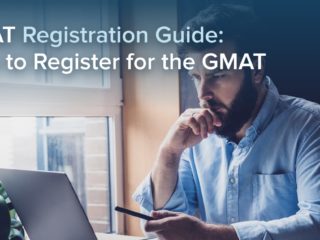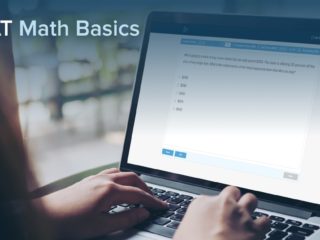| Getting your Trinity Audio player ready... |
As you may already know, the Graduate Management Admission Test (GMAT) is a standardized, computer-adaptive test (CAT) that tests the skills necessary for success in the business world, skills such as critical thinking, logical reasoning, data analysis, and basic math and English skills. Business schools evaluate GMAT scores as a measure of how an MBA hopeful will perform in their programs, and earning a top GMAT score can be a huge gold star on a candidate’s application. Although most MBA programs now also accept the Graduate Record Examination (GRE), the GMAT remains the more commonly taken exam for admission to business school.
KEY FACT:
Although most MBA programs now accept either the GMAT or the GRE, the GMAT remains the more commonly taken exam for admission to business school.
It’s important to understand the GMAT format, so that you can be prepared to withstand the rigors of a challenging exam that takes more than 2 hours to complete. So, in this article, I’ll provide a detailed breakdown of the GMAT exam format, everything from section order and time constraints to computer-adaptivity and question types.
It’s important to understand the GMAT format, so that you can be prepared to withstand the rigors of a challenging exam that takes more than 2 hours to complete.
Here are the topics we’ll cover:
- How the GMAT is Administered
- The GMAT Exam Structure
- GMAT Question Formats
- GMAT Section Order
- Question-Level Adaptivity on the GMAT
- Key Takeaways
- Frequently Asked Questions (FAQ)
- What’s Next?
To start, let’s review how the GMAT is administered.
How the GMAT is Administered
As you may be aware, you have 2 ways to take the GMAT: in person at a testing center, and online at home. While the GMAT itself is the same in-person and online, how the test is administered differs slightly.
The in-person GMAT is administered at a designated GMAT test center. A proctor administers the exam in a testing room where each test-taker sits at a computer station. Prior to entering the exam room, you’ll have the opportunity to store your belongings in a locker.
Test-takers undergo a roughly 15-minute check-in process to verify their identities with the proctor before the start of their GMAT and are monitored by the proctor throughout the exam, to ensure that they comply with the strict rules and procedures of the GMAT. The proctor also assists any test-takers who may have questions during the exam, need additional scratch paper or pens, or experience a technical difficulty related to the computer presentation of the exam.
For the online GMAT, the exam proctor will administer your exam via your webcam. You’ll still go through a check-in process to verify your identity, but you’ll also use your webcam to show the proctor that your workspace follows the online GMAT rules and regulations. Additionally, the proctor will monitor you as you take the exam and be available to help with any technical issues you encounter. To learn more about taking the GMAT online, check out our guide to the online GMAT.
KEY FACT:
While the in-person and online GMATs are the same exam, they differ slightly in how they are administered.
Now that we know how the exam is administered, let’s look at an overview of the GMAT test format.
The GMAT Exam Structure
As I already mentioned, the GMAT exam takes more than 2 hours to complete. At the beginning of the exam, you will navigate through a series of introductory screens. Those screens will display some exam instructions and allow you to select the order of your GMAT sections (we’ll discuss that later).
The GMAT consists of 3 sections containing a total of 64 multiple-choice questions, with a total GMAT test duration of 2 hours 15 minutes (not including the optional 10-minute break). The multiple-choice questions are not subject to individual time limits, but each section is.
The GMAT exam sections are as follows:
| Section | Number of Questions | Time Limit |
|---|---|---|
| Data Insights | 20 questions | 45 minutes |
| Quantitative Reasoning | 21 questions | 45 minutes |
| Verbal Reasoning | 23 questions | 45 minutes |
After either your first or second section, you can choose to take an optional 10-minute break, when you can leave the exam room to use the restroom, get a drink of water or a snack, or stretch your legs. During the break, you can access certain items that you stored in your locker, such as food or medication. However, you cannot exit the test center to, say, grab something from your car, run to a coffee shop, or make a phone call.
Between check-in, the break, and the exam itself, you can expect to spend up to 3 hours at the GMAT test center. So, you can see why mental and physical stamina are important components of GMAT success!
KEY FACT:
Between check-in, breaks, and the exam itself, you can expect to spend up to 3 hours at the GMAT test center.
Now that we know the basic GMAT format, let’s take a look at the types of questions you’ll encounter in each GMAT section.
GMAT Question Formats
Each of the 3 GMAT sections is designed to test different skills and thus features different question formats and types. Of course, there is some crossover among the sections. For instance, the Data Insights section tests many of the same skills needed for both the Verbal and Quantitative sections. Nevertheless, the various GMAT sections test these skills in different ways — not only in terms of the content tested but also in terms of how the content is presented. So, let’s take a look at the different question types and formats you’ll see in each section, starting with the Quant section.
Quantitative Reasoning
In the new GMAT format, all Quant questions are multiple-choice Problem Solving questions. These questions may be in the format of a word problem, present an equation and ask you to solve for certain values, or involve number properties, for example. For each of these questions, you’ll select 1 answer from 5 choices.
Here is one example of a Problem Solving question:
(Get the answer to this question and see more GMAT sample questions here.)
In general, all GMAT Quant questions test your ability to use logic to apply your knowledge of math rules and formulas in the most efficient way possible. The Quant section does not test your ability to perform lengthy calculations. For that reason, you do not have access to a calculator during the Quant section of the GMAT. Any calculations that you do need to perform will be done on the dry-erase scratch pad (or the dry-erase whiteboard, for the online GMAT) given to you before the start of your exam, If you are well-versed in GMAT Quant concepts and content, that scratch pad should be all you need.
KEY FACT:
GMAT Quant questions test your ability to use logic to apply your knowledge of math rules and formulas in the most efficient way possible.
Concerned about solving GMAT Quant questions without the use of a calculator? These strategies can help.
Next, let’s discuss the Verbal Reasoning section of the GMAT.
Verbal Reasoning
The Verbal section consists of a roughly even mix of 2 types of questions: Critical Reasoning and Reading Comprehension. While both types are multiple-choice, each type has a different format.
Critical Reasoning questions present a passage consisting of a short argument or set of statements and ask you to evaluate some aspect of what is presented. For instance, a CR question may ask what assumption the argument makes, or which statement must be true if all of the statements in the passage are true. You will select 1 of 5 answer choices for each question.
Check out an example of a Critical Reasoning question here.
Reading Comprehension questions present you with a passage and typically 3 or 4 questions about that passage. For each question, you’ll select 1 of 5 answer choices. These questions test your ability to read carefully, accurately interpret information, and identify relationships between ideas.
For both CR and RC questions, no specialized knowledge is required: any necessary information will be provided in the passages associated with the questions.
KEY FACT:
GMAT Verbal questions test your ability to interpret and analyze information and apply logical reasoning.
Let’s now examine the GMAT Data Insights section.
Data Insights
There are 5 types of DI questions: Data Sufficiency, Multi-Source Reasoning, Two-Part Analysis, Table Analysis, and Graphics Interpretation. These questions test your data analysis ability and may require Quant concepts, Verbal concepts, or logical reasoning to solve.
Data Sufficiency questions present you with a problem and two statements that provide further relevant information. You will determine which information is sufficient to answer the question.
Here is a Data Sufficiency example question:
Multi-Source Reasoning questions ask you to evaluate data presented in multiple formats, such as charts, tables, and text, in order to answer a single question.
Two-Part Analysis questions present you with a scenario and 2 columns of choices. You will select 1 choice from each column (2 choices total) to answer the question based on the scenario.
Table Analysis questions present data in a sortable, spreadsheet-like format and ask you to evaluate statements about the data. For example, you might have to analyze the data to determine whether a particular statement is true.
Graphics Interpretation questions require you to analyze a graph or diagram to fill in blanks in 2 statements. Each statement contains one blank with 3 or 4 answer choices, and you select 1 answer for each blank (2 answers total).
This variety of question types can make the DI section seem overwhelming. However, if you are well-prepared for Quant and Verbal, DI preparation is relatively simple. In fact, most of your DI preparation involves getting comfortable with question formats rather than learning new content. Furthermore, unlike in the Quant section, an on-screen calculator is provided for the DI section.
KEY FACT:
The Data Insights section tests data analysis and critical thinking skills, as well as Quant and Verbal skills.
Next, let’s discuss an important aspect of the GMAT format: section order selection.
GMAT Section Order
GMAC allows test-takers to choose the order in which they see the sections of the GMAT on test day. This option gives test-takers the flexibility to tailor the test-taking experience to their skills and preferences. For instance, if Verbal is your strongest area and you tend to get tired toward the end of the exam, you may want to choose the section order that allows you to see the Verbal section last, so that your mind is fresher for the sections that present more of a challenge.
The Select Section Order screen is the final introductory screen that you will see right before you start your GMAT exam. On that screen, you will have 1 minute to choose from 6 possible section orders:
- Data Insights → Quant → Verbal
- Data Insights → Verbal → Quant
- Quant → Verbal → Data Insights
- Quant → Data Insights → Verbal
- Verbal → Data Insights → Quant
- Verbal → Quant → Data Insights
If you don’t make a selection within 1 minute, the computer will be selected for you by the computer. For that reason, it’s essential that you decide on your preferred section order before you sit for your GMAT. Every test-taker is different, so the best section order for one person may not be preferable for someone else. Meanwhile, for some GMAT test-takers, section order does not noticeably affect how they perform on the test.
KEY FACT:
GMAC allows test-takers to choose the order in which they see the sections of the GMAT on test day.
Now that we know the structure of the GMAT sections and the various formats of its questions, let’s take a look at the GMAT’s particular “brand” of computer-adaptivity and how that adaptivity affects the rules of the exam.
Question-Level Adaptivity on the GMAT
A key aspect of the GMAT is that the Quant, Verbal, and Data Insights sections are computer-adaptive on a question-by-question basis. Simply, this means that the questions you see are selected by the computer on the basis of your answers to the previous questions.
For example, each section starts with a medium-difficulty question. If you answer that first question correctly, the second question in the given section will be a bit harder. Conversely, if you answer the first question incorrectly, the second question will be a bit easier. As you answer more questions in the section correctly or incorrectly, the difficulty of the next questions you see increases or decreases, respectively (or remains roughly the same, depending on your performance as you progress through the section). Interestingly, there is some minor carryover between sections: performing well in a section may slightly increase the difficulty of your first question in the subsequent section.
KEY FACT:
The GMAT algorithm selects questions for you based on your answers to previous questions.
One key benefit of the GMAT format change is the ability to change answers to questions you’ve already answered. Let’s discuss.
Question Review & Edit
On the old format of the GMAT, you were unable to edit answers to previous questions. However, on the new version, you can change up to 3 answers in each section of the GMAT.
So, you do have some ability to correct mistakes or review questions that you weren’t sure about, but that ability is limited. For the GMAT scoring system to work, most of your answers must stay the same.
As you work through each section, you’ll be able to bookmark as many questions as you’d like. When you reach the end of the section, a Question Review & Edit screen appears, and you’ll be able to return to any question in that section. The questions you bookmarked will appear with a bookmark icon for easy reference.
Given GMAT time management constraints, this tool is one that must be used strategically. At the end of a section, quickly review the questions you’ve bookmarked (time permitting, of course) and choose the questions that you have the best chance of getting correct with your remaining time.
KEY FACT:
At the end of each section, you can review as many questions as time allows, but you can only change up to 3 answers.
While you can change answers at the end of the section, you do have to answer each question as you see it. Let’s discuss.
You Can’t Skip Questions
Remember, the GMAT is computer-adaptive at the question level: the questions you see are determined by your answers to previous questions. For the algorithm to choose the next question, you must answer each one as you see it.
So, there’s no option to bypass a GMAT question that has you completely stumped: you have to select an answer to move on. If you find yourself in that situation on test day, do your best to make an educated guess, flag it, and keep working. If you have time at the end of the section, you can give the question your best effort.
KEY FACT:
The GMAT does not allow you to skip questions without answering. You must answer each one as it is presented.
Let’s now review what we’ve learned about the GMAT format.
Key Takeaways
In this article, we discussed several crucial points about the format of the GMAT.
- The GMAT consists of 3 sections: Quant, Verbal, and Data Insights. Each section takes 45 minutes, for a total testing time of 2 hours and 15 minutes, not including the optional 10-minute break.
- Quant questions are designed to test your ability to use logic to apply math concepts in efficient ways.
- Verbal questions test your ability to interpret and analyze information and apply logical reasoning.
- Data Insights questions test your data analysis and critical thinking skills, as well as your Quant and Verbal skills.
- You can choose the order in which you see each section of the GMAT.
- The GMAT is computer-adaptive at the question level: the computer selects questions for you based on your performance on previous questions in that section.
- You have the ability to review and edit questions at the end of each section, but you can only make up to 3 changes to your answers.
- You cannot skip questions. For the GMAT algorithm to work, you must answer each question in order to move to the next one.
Frequently Asked Questions (FAQ)
What is the format of the GMAT?
The GMAT consists of 3 sections containing a total of 64 multiple-choice questions, with a total GMAT test duration of 2 hours 15 minutes (not including the optional 10-minute break). You can choose the order in which you face the 3 sections.
Is the GMAT multiple choice?
While each section features multiple question types, every GMAT question (21 Quant questions, 23 Verbal questions, 20 Data Insights questions) is multiple-choice. The number of answer choices may vary depending on the question type.
How is the GMAT structured?
While each GMAT-taker sees the same 3 sections, the exact structure of your GMAT is up to you. Because the exam lets you select your section order, you can face the sections in any order you like. Additionally, you can choose when to take your optional break: after the first or second section.
What’s Next?
Now that you know all there is to know about the GMAT structure, you may find it helpful to read this article about how long it takes to study for the GMAT.
For further information about each GMAT section, check out these guides to the Quant, Verbal, and Data Insights sections.



